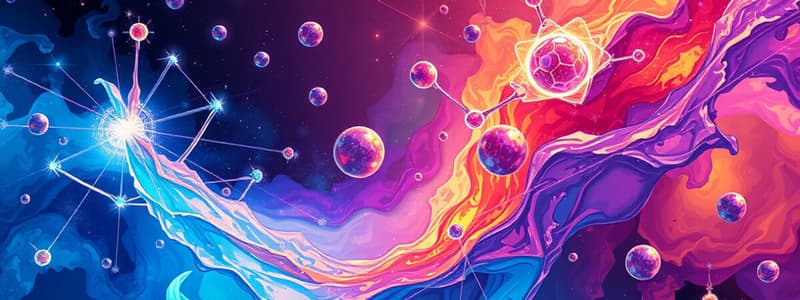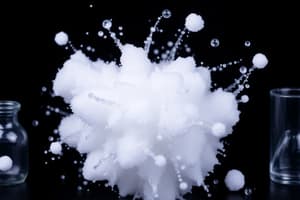Podcast
Questions and Answers
What is matter composed of?
What is matter composed of?
- Atoms and molecules
- Electrons and particles only
- Atoms and subatomic particles (correct)
- Protons and neutrons only
Which property defines a solid state of matter?
Which property defines a solid state of matter?
- Has a definite volume and shape (correct)
- Has no definite shape but occupies a definite volume
- Particles are only loosely attracted to each other
- Particles move freely and rapidly
Which of the following best defines inorganic matter?
Which of the following best defines inorganic matter?
- Matter that comes from non-living things (correct)
- Matter that can exist in various states
- Matter that comes from living organisms
- Matter that has mass but no volume
In which state of matter do particles have a definite volume but no specific shape?
In which state of matter do particles have a definite volume but no specific shape?
What role does energy play in chemical interactions involving matter?
What role does energy play in chemical interactions involving matter?
What is the relationship between matter and space?
What is the relationship between matter and space?
What type of forces shape the interactions of matter in the universe?
What type of forces shape the interactions of matter in the universe?
What distinguishes organic matter from inorganic matter?
What distinguishes organic matter from inorganic matter?
Which statement best describes intensive physical properties?
Which statement best describes intensive physical properties?
Which of the following is an extensive physical property?
Which of the following is an extensive physical property?
What is the primary characteristic of a chemical property?
What is the primary characteristic of a chemical property?
Which of the following examples illustrates a chemical property?
Which of the following examples illustrates a chemical property?
What does the property of impenetrability state?
What does the property of impenetrability state?
What is density defined as?
What is density defined as?
Which property of matter is linked to the tendency of a body to maintain its state of rest or motion?
Which property of matter is linked to the tendency of a body to maintain its state of rest or motion?
Which characteristic reflects the gravitational force acting on a body?
Which characteristic reflects the gravitational force acting on a body?
What is a physical change?
What is a physical change?
Which process is an example of an endothermic reaction?
Which process is an example of an endothermic reaction?
What does the Law of Conservation of Mass state?
What does the Law of Conservation of Mass state?
Which of the following reactions releases energy?
Which of the following reactions releases energy?
Which of the following is NOT a characteristic of a chemical change?
Which of the following is NOT a characteristic of a chemical change?
What type of reaction occurs when water freezes?
What type of reaction occurs when water freezes?
Which of the following is an exothermic process?
Which of the following is an exothermic process?
What occurs during an endothermic reaction?
What occurs during an endothermic reaction?
Which of the following describes the properties of gas?
Which of the following describes the properties of gas?
In what condition is plasma typically formed?
In what condition is plasma typically formed?
Which of the following is NOT a characteristic of a homogeneous mixture?
Which of the following is NOT a characteristic of a homogeneous mixture?
Which of the following best describes a compound?
Which of the following best describes a compound?
Which example represents a heterogeneous mixture?
Which example represents a heterogeneous mixture?
Which of these options is considered a physical property of matter?
Which of these options is considered a physical property of matter?
What is a key feature of a pure substance?
What is a key feature of a pure substance?
In the context of mixtures, which statement is true?
In the context of mixtures, which statement is true?
Flashcards are hidden until you start studying
Study Notes
Chemistry and Matter
- Chemistry studies properties, structure, interactions of matter, and energy changes during these interactions.
- The universe consists of two fundamental elements: Matter and Energy.
- Matter has mass and occupies space, characterized by its particulate nature composed of atoms.
Nature of Matter
- Matter forms the tangible substances in the physical world, made up of atoms, which consist of protons, neutrons, and electrons.
- Matter can exist in four states: solid, liquid, gas, and plasma, influenced by temperature and pressure.
- Celestial bodies and living organisms are all forms of matter, interacting via gravitational, electromagnetic, and nuclear forces.
Classification of Matter
According to Origin
- Inorganic Matter: Derived from non-living sources.
- Organic Matter: Derived from living organisms.
According to State
- Solid:
- Rigid with definite volume and shape.
- Particles are fixed and strongly attracted, allowing only vibrational motion.
- Liquid:
- Definite volume but takes the shape of its container.
- Particles are loosely held and can move past each other.
- Gas:
- No fixed volume or shape, taking the entire shape of its container.
- Highly compressible with particles that move freely.
- Plasma:
- Exists under extreme conditions, like in stars or fluorescent lamps.
- Formed when gas is heated to the point of ionization.
According to Composition
- Pure Substances:
- Elements: One type of atom (e.g., Carbon, Sodium, Aluminum).
- Compounds: Two or more chemically combined elements in fixed proportions (e.g., Water, Sodium Chloride).
- Mixtures:
- Combination of elements or compounds retaining distinct properties.
Types of Mixtures
- Homogeneous Mixture: Uniform in composition, consists of one phase (e.g., sugar solution).
- Heterogeneous Mixture: Non-uniform composition with distinct substances (e.g., sand and iron filings).
Properties of Matter
Physical Properties
- Measurable attributes of matter, categorized as:
- Intensive Properties: Independent of sample size (e.g., density, color).
- Extensive Properties: Dependent on sample size (e.g., mass, volume).
Common Properties
- Mass: Quantity of matter in an object.
- Inertia: Resistance to change in motion.
- Weight: Gravitational attraction toward Earth.
- Volume: Space occupied by matter.
- Density: Mass-to-volume ratio.
- Impenetrability: No two objects can occupy the same space simultaneously.
Chemical Properties
- Observable during a reaction and alters substance identity (e.g., flammability, rusting).
- Indicators include reactivity and heat of combustion.
Changes in Matter
- Physical Change: Alters form but not chemical identity (e.g., phase changes).
- Chemical Change: Alters substance to form a new identity, involves energy changes.
- Endothermic Reactions: Absorb energy (e.g., photosynthesis).
- Exothermic Reactions: Release energy (e.g., combustion).
Law of Conservation of Mass
- States total mass remains unchanged during matter changes; mass cannot be created or destroyed.
Studying That Suits You
Use AI to generate personalized quizzes and flashcards to suit your learning preferences.




